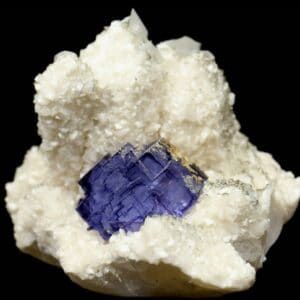Dolomite is relatively common and most rockhounds are not looking to collect Dolomite on its own. Now, if you own a nice house or have a nice backyard then you’re a collector of Dolomite but we’re not here for the construction uses.
You’ve probably come across Dolomite while digging for and viewing rocks and minerals. It makes for a great host rock and the images below prove it.
Most rocks rich in Dolomites were initially deposited as calcium carbonate mud that was postdepositionally altered by magnesium-rich pore waters to form them.
Dolomite is found in hydrothermal veins and is often associated with Fluorite, Barite, Pyrite, Galena, Sphalerite, and Chalcopyrite in those locations. Within the hydrothermal veins, Dolomite often occurs as Rhombohedral crystals that can occasionally have curved faces.

Dolomite Limestone
Dolomite Limestone isn’t a new discovery; it’s been around for a long time and has gone through many name changes throughout the years. Originally, Dolomitic Limestone was originally known as Magnesium Limestone because it contains high levels of magnesium, not just calcium.
Today, these rocks are mostly referred to as Dolostone, Dolomite, Dolomite Rock, or Dolomitic Limestone. Different names, same stone.
How Dolomite is Formed
Believe it or not, scientists aren’t really sure about the specific details behind how Dolomite forms. However, there are some working theories and general science involved.
Dolomite is formed through a process known as ‘dolomitization’ which occurs when lime mid and limestone are altered by magnesium-rich groundwater, which converts calcium into magnesium. Often, it’s incredibly difficult to distinguish between regular Limestone and Dolomite because of their incredibly similar appearance.
Whenever there is doubt, hydrochloric acid is used to determine whether specimens are Dolomitic or regular Limestone. When using this identification process, Limestone will effervesce very quickly when it’s treated with cold dilute hydrochloric acid, while Limestone produces a weak effervescence.
Dolomitization causes a few composition and structural changes in rocks. The process Limestone undergoes to become Dolomite causes a slight volume reduction, which results in a porous, trigonal-rhombohedral structure. While this might sound scientific and complex, it basically means the rocks get smaller, and grains develop more pores and divots.
Because of its porousness, Dolomite becomes an incredible reservoir rock, which is often sought after for exploration in natural gas and oil ventures. Dolomite contains fewer impurities like silt and clay than regular Limestone does, and it can act as a host rock for lead, zinc, and copper deposits, which leads to a variation of hues and colors.
The last two paragraphs are very important to understand if you spend a ton of time out in the field. Dolomite is the perfect host rock or matrix for minerals to grow. Take for example the Herkimer diamond below. The Dolomite host rock produces pockets where the mineral-rich fluid flows and deposits itself. From these deposits, crystals and minerals form, and later on down the road (thousands of years later) rockhounds discover them.

Dolomite Rock Color
Dolomite crystals can be colorless, white, buff-colored, blue-hued, and pink-hued. If you don’t have the crystal form then you can visibly see granular Dolomite in rocks that are often light to dark gray, white, or tan.
Dolomite crystals range from transparent to translucent. However, Dolomite grains in rocks are usually translucent to nearly opaque.
The luster ranges from subvitreous to dull.
Dolomite, like Calcite, Cleaves into six-sided polyhedrons with diamond-shaped faces. However, they differ from those of Calcite, and the difference can be used to distinguish the two minerals within coarse-grained rocks like marble.
Dolomite has a hardness of 3.5 to 4 on the Mohs hardness scale and contains a specific gravity of 2.85.

Dolomite Rock Uses
Dolomite is used as a source of magnesium metal and magnesia.
Dolostone is often used as an aggregate for both bitumen and cement mixes instead of limestone.
The use of Dolostone as a flux has actually increased, especially since environmental contaminations have become a consideration because the resulting slag can be used as a lightweight aggregate, whereas that which forms when Limestone is used cannot. This is because Dolostone-based slag doesn’t slake or disintegrate in water, while Limestone-based slag does.
A unique, isolated Dolomite specimen in Eugue, Spain, has provided colorless transparent crystals resembling the Iceland Spare variety of Calcite.
A Dolomite occurrence of Kolwezi in the Congo has produced some incredibly fascinating, cobalt-rich, hot pink specimens, making them popular.
- Identify Enstatite - March 12, 2024
- Identify Cerussite - March 3, 2024
- Identify Bytownite - February 18, 2024
